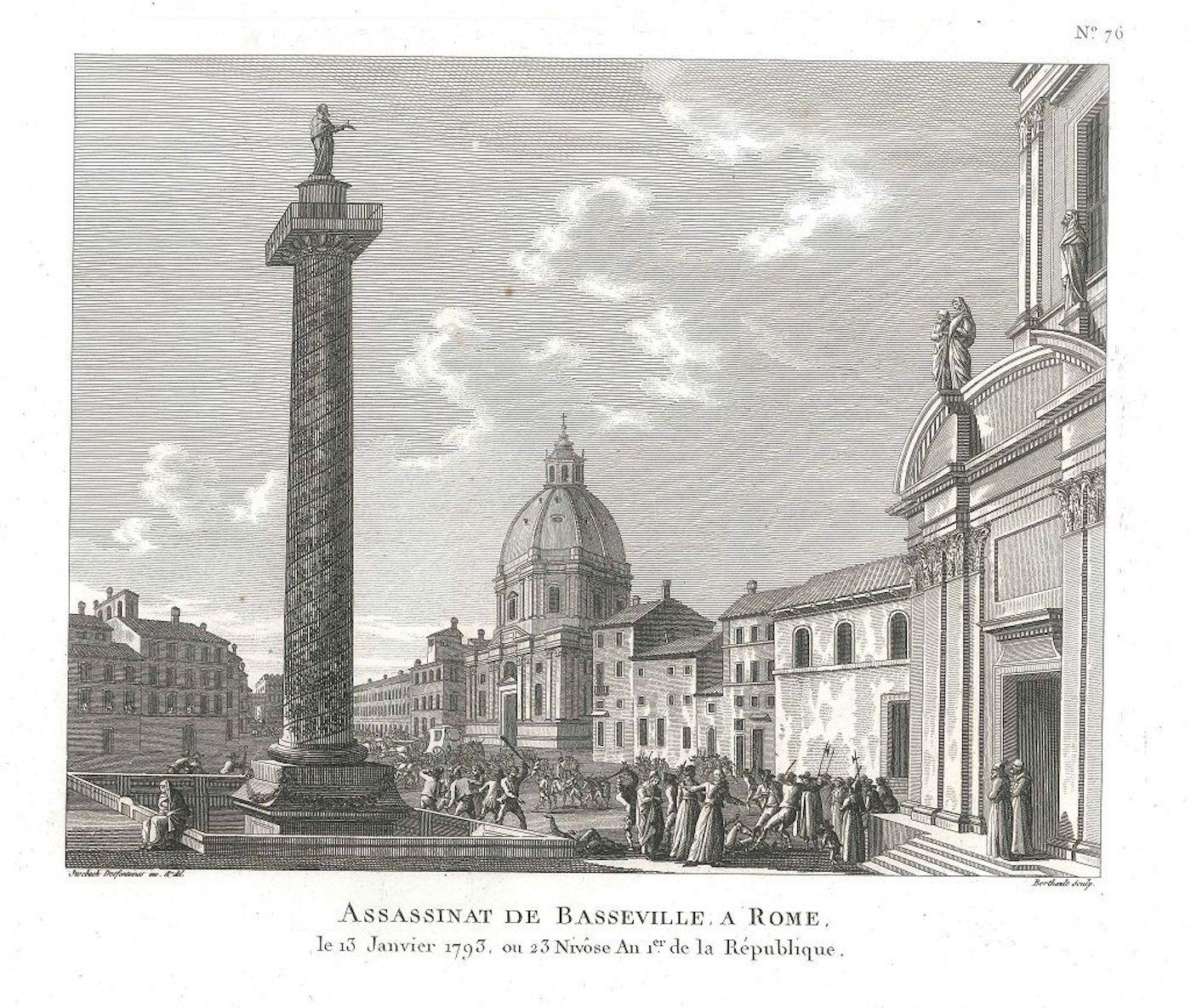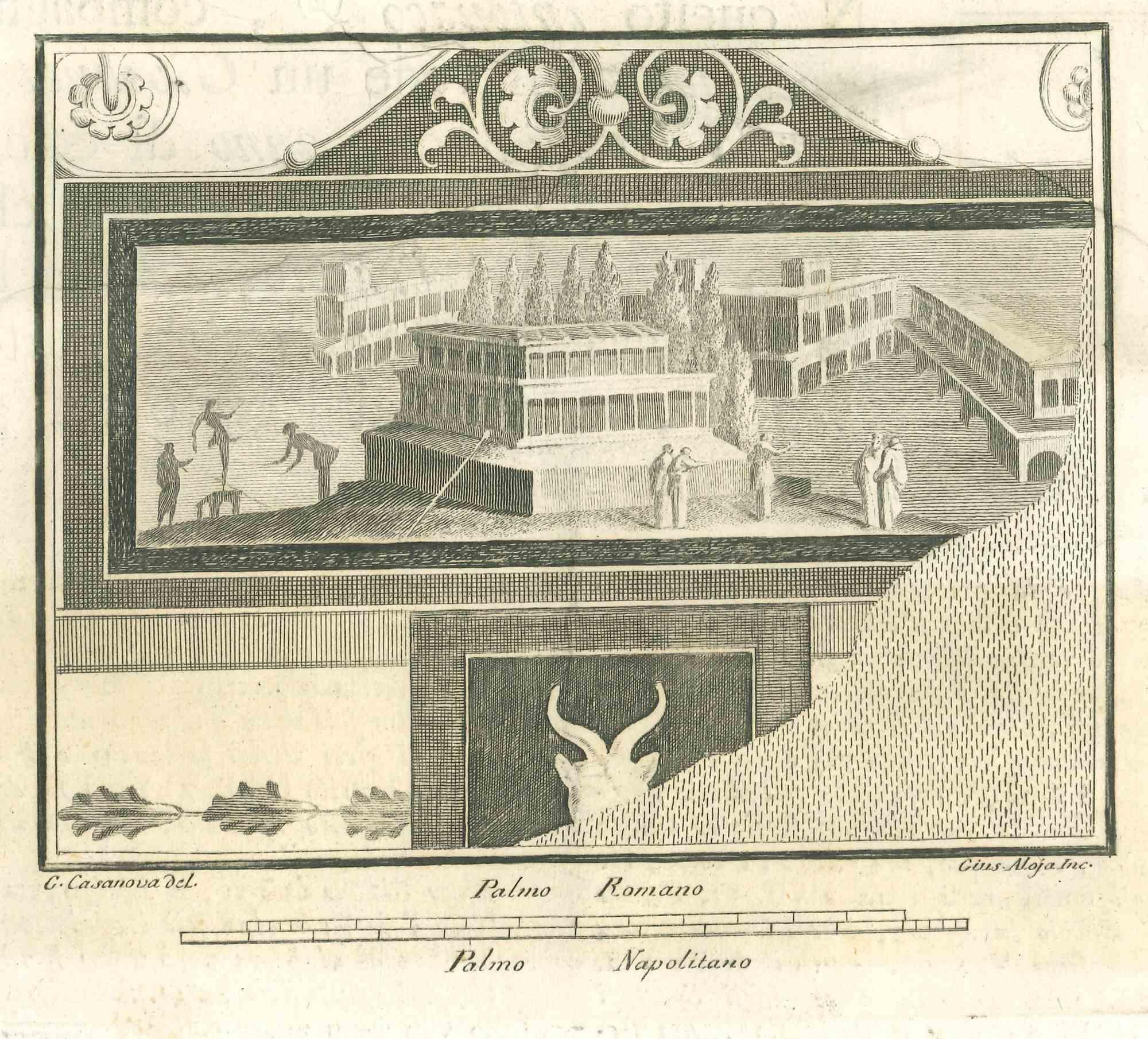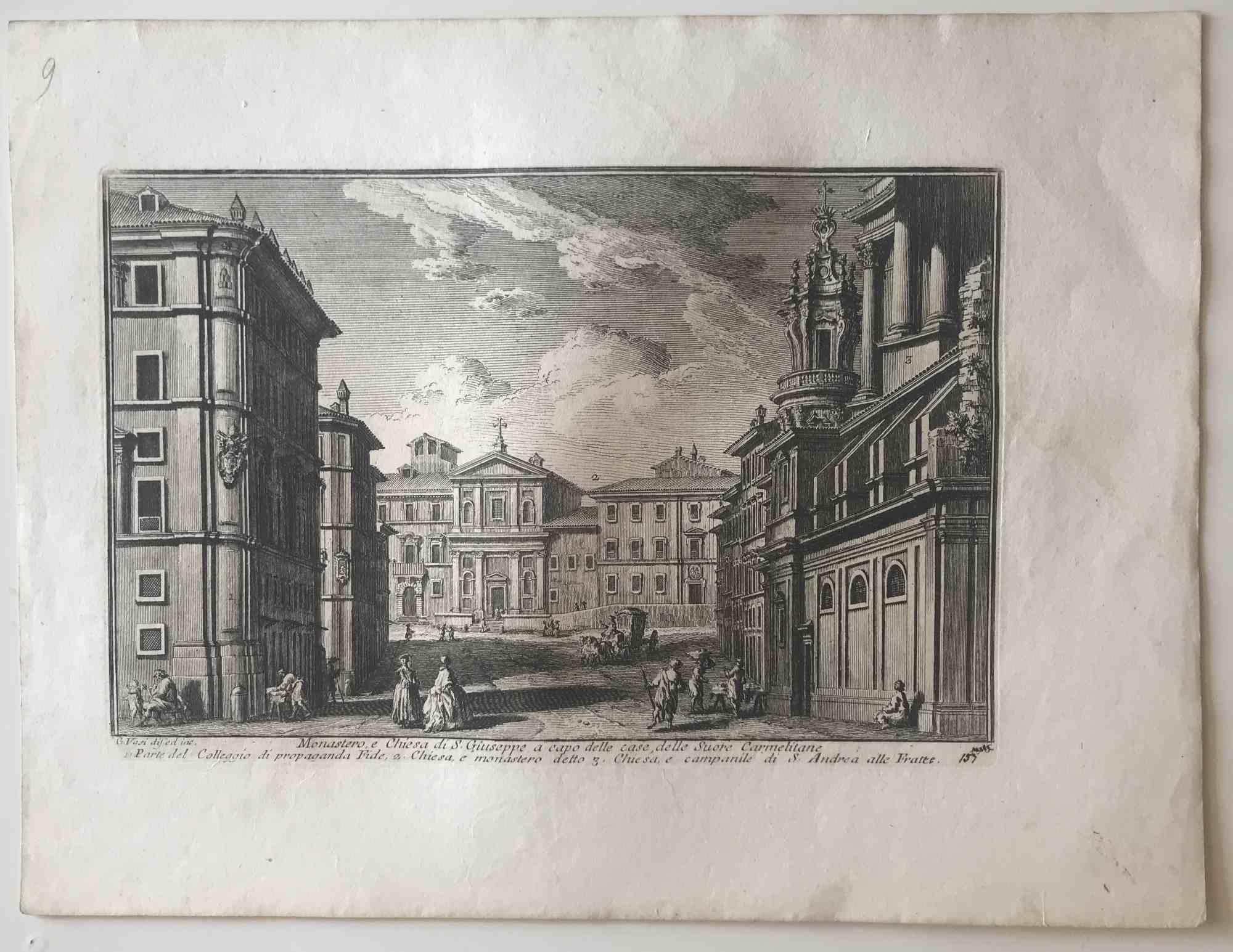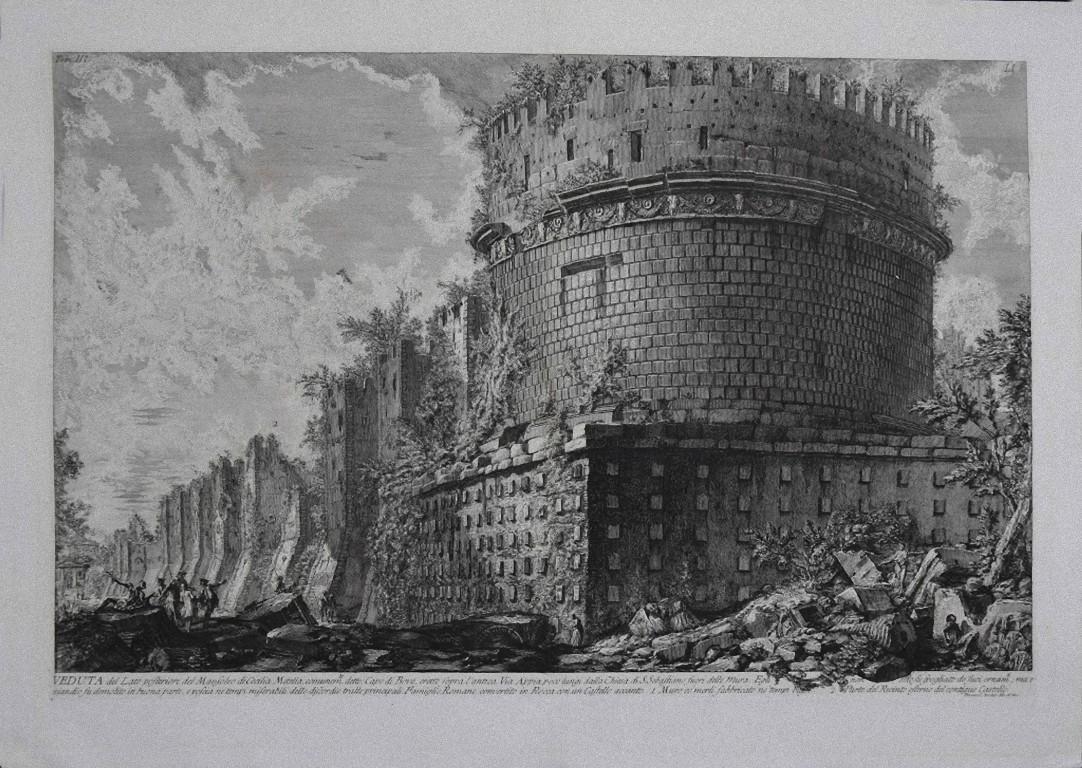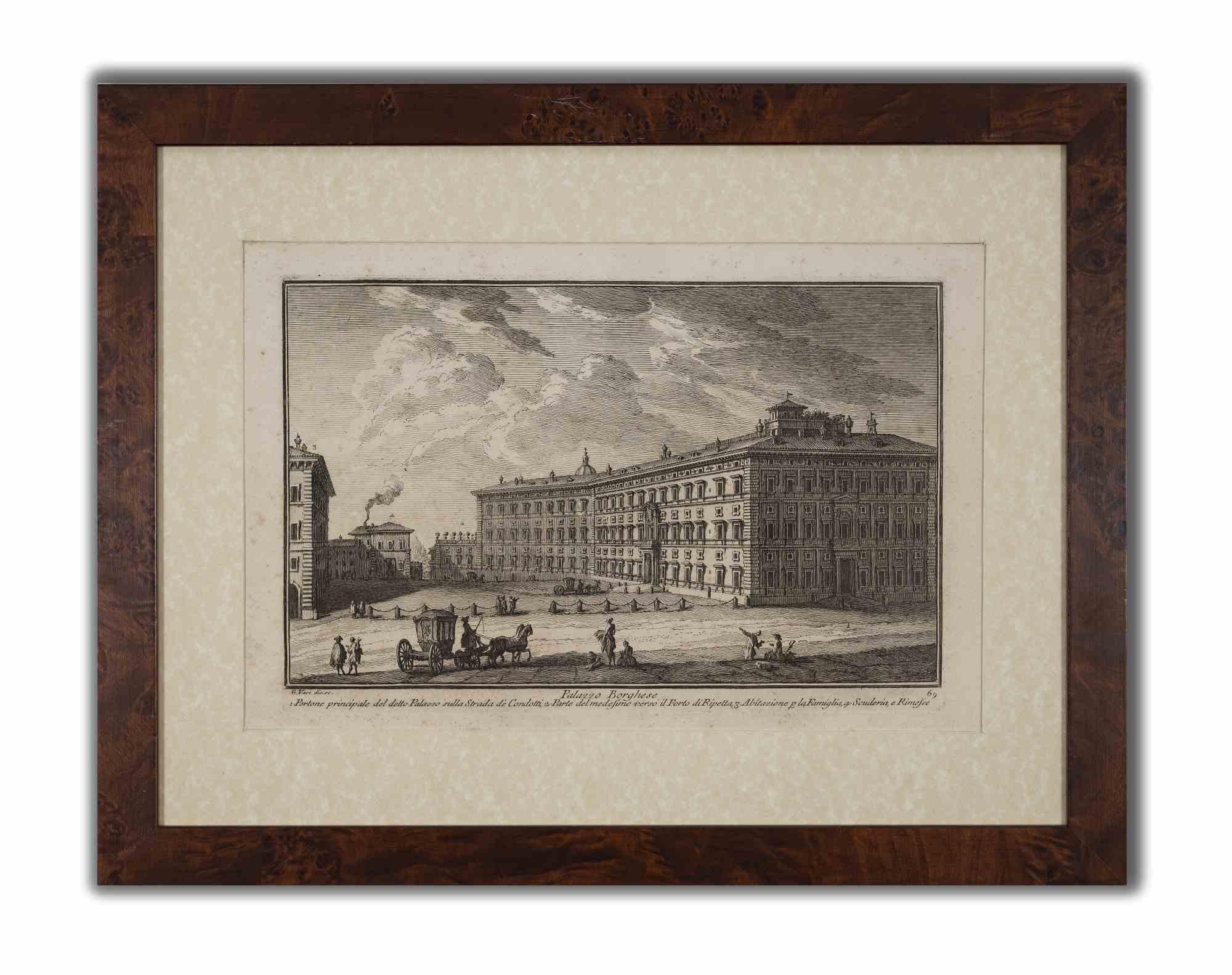Items Similar to 18th Century Etching of "Chiesa di S. Lucia" in Rome by Giuseppe Vasi
Want more images or videos?
Request additional images or videos from the seller
1 of 9
Giuseppe Vasi 18th Century Etching of "Chiesa di S. Lucia" in Rome by Giuseppe Vasi1747
1747
About the Item
This 18th century etching is entitled "Chiesa di S. Lucia alle Botteghe Oscure" by Giuseppe Vasi was published in Rome in 1747 in Vasi's 'Magnificenze di Roma Antica e Moderna', which illustrated the magnificent architecture of ancient and more modern Rome. It depicts the appearance of the Church of Saint Lucy in Selci. It is an ancient Roman Catholic church, located in Rome, dedicated to Saint Lucy, a 4th-century virgin and martyr. The church in around the 8th century above the ruins of a Roman structure, the Portico of Livia. Vasi has include a numbered guide to the architectural highlights and landmarks in the scene.
This antique Vasi engraving of Roman architecture is framed in a bronze-colored wood frame with gold trim and a cream-colored French mat with a broad tan band. The frame measures 14.5" x 22.32" x . and 75". The print is in very good condition. There is another Vasi engraving of Roman architecture available on 1stdibs that is in an identical frame and mat. See item # LU117326015842. The pair would make an attractive display grouping. A discount is available for purchase of both prints.
Giuseppe Vasi (1710-1782) was an Italian engraver and architect, best known for his illustrated 'Vedute Roma Antica' (views of ancient Rome), published from 1746 to 1761. Among his pupils was Giovanni Battista Piranesi. Piranesi worked together with him on the Vedute and some are signed both by Vasi and Piranesi. The two disagreed on the movement during their time to denigrate the work of Baroque architects, such as Bernini and Borromini. Vasi favored the more modern architectural approach approach and Piranesi favored the more classical architecture. They often had extreme disagreements and reportedly Piranesi threatened to kill his teacher.
- Creator:Giuseppe Vasi (1710 - 1782, Italian)
- Creation Year:1747
- Dimensions:Height: 14.5 in (36.83 cm)Width: 20.32 in (51.62 cm)Depth: 0.75 in (1.91 cm)
- Medium:
- Movement & Style:
- Period:
- Condition:
- Gallery Location:Alamo, CA
- Reference Number:
Giuseppe Vasi
Giuseppe Vasi (1710-1782) was an Italian engraver and architect, best known for his illustrated 'Vedute Roma Antica' (views of ancient Rome), published from 1746 to 1761. Among his pupils was Giovanni Battista Piranesi. Piranesi worked together with him on the Vedute and some are signed both by Vasi and Piranesi. The two disagreed on the movement during their time to denigrate the work of Baroque architects, such as Bernini and Borromini. Vasi favored the more modern architectural approach approach and Piranesi favored the more classical architecture. They often had extreme disagreements and reportedly Piranesi threatened to kill his teacher.
About the Seller
5.0
Gold Seller
These expertly vetted sellers are highly rated and consistently exceed customer expectations.
Established in 2011
1stDibs seller since 2019
242 sales on 1stDibs
Typical response time: 1 hour
- ShippingRetrieving quote...Ships From: Alamo, CA
- Return PolicyA return for this item may be initiated within 7 days of delivery.
More From This SellerView All
- Piranesi 18th C. Etching "Reliquiae Theartri Pompejani" an Ancient Roman TheaterBy Giovanni Battista PiranesiLocated in Alamo, CAThis a framed Giovanni Battista Piranesi (1720-1778) etching entitled "Reliquiae Theartri Pompejani" (Remains of the Theatre of Pompey) from "Il Campo Marzio dell'Antica Roma" (The C...Category
Mid-18th Century Old Masters Landscape Prints
MaterialsEtching
- Fabricius (Ponte Cestio) Bridge : Framed 18th C. Piranesi Architectural EtchingBy Giovanni Battista PiranesiLocated in Alamo, CAThis framed 18th century etching by Giovanni Battista Piranesi is entitled "Dimostransi nella Tav. presente la Pianta, ed Elevazione del Ponte, oggi detto Quattro Capi egli è antichissimo, e chiamavasi Fabrizio da L. Fabrizio Presid. delle Strade, che lo fabbrico' nel fine della Repubblica. "(The Plan and Elevation of the Bridge, today called Quattro Capi. The architect is very ancient, and was called Fabrizio da L. Fabrizio Presid. delle Strade, who built it at the end of the Republic). This is plate 18 in volume 4 of Piranesi's "Le antichita romane opera di Giambatista Piranesi architetto veneziano" (Roman antiquities by Giambatista Piranesi Venetian architect). It was published in Rome in 1756-1757. This etching depicts the plan and elevation of the bridge now called the Ponte dei Quattoro Capi or Ponte Cestio (Bridge of the Four Heads), which in antiquity was called the Bridge of Fabricius after L. Fabricius, the Superintendant of the Streets who built it at the end of the Republic, around 62 BC. It was also been known in the Middle Ages as ‘Ponte Giudeo’ (Bridge of the Jews). The bridge crossed from the left bank or northeast side of the Tiber River to Tiber Island...Category
1750s Old Masters Landscape Prints
MaterialsEtching
- Ruins of the Roman Baths of Belisarius: A 19th C. Etching by Luigi RossiniBy Luigi RossiniLocated in Alamo, CAThis early 19th century etching entitled "Veduta degl' Avanzi delle Torri di Belisario Dalla parte che guarda l' Interno della Città, vicino a Porta S. Giovanni, A. Mura Aureliane" (...Category
1820s Old Masters Landscape Prints
MaterialsEtching
- Four Framed Hogarth Engravings "Four Times of the Day"By William HogarthLocated in Alamo, CAThe four plates in this "Four Times of the Day" set were created utilizing both engraving and etching techniques by William Hogarth in 1738. Hogarth's original copper plates were refurbished where needed by James Heath and these engravings were republished in London in 1822 by Braddock, Cradock & Joy. This was the last time Hogarth's original copper plates were used for printing. Most were melted down during World War I for the construction of bombs. Printed upon early nineteenth century wove paper and with large, full margins as published by William Heath in 1822. The inscription below each print reads "Invented Painted & Engraved by Wm. Hogarth & Publish'd March 25. 1738 according to Act of Parliament". These large folio sized "Four Times of the Day" engravings/etchings are presented in complex gold-colored wood frames with black bands and scalloped gold inner trim. A majority of each thick impressive frame is covered with glass applied near the outer edge. Each frame measures 25.75" high, 22.25" wide and 1.88" deep. There are a few small dents in the edge of these frames, which are otherwise in very good condition. "Morning" has two focal areas of discoloration in the upper margin and some discoloration in the right margin, a short tear in the left margin and a short tear or crease in the right margin. "Noon" has a spot in the upper margin that extends into the upper image, but it is otherwise in very good condition. "Evening" has a faint spot in the upper margin, but it is otherwise in very good condition. "Night" is in excellent condition. The "Four Times of the Day" series is in the collection of many major museums, including: The British Museum, The Metropolitan Museum of Art, The Tate Museum, The Chicago Art Institute and The Victoria and Albert Museum. Through this series Hogarth is portraying early 18th century London street life at "Four Times of the Day". His characters are exhibiting their personalities, quircks, strange activities, but he also wants to draw attention the disparities between the wealthy aristocracy and the common working class. Plate 1, "Morning" depicts morning in Covent Garden in the winter in front of Tom King...Category
Mid-18th Century Old Masters Landscape Prints
MaterialsEngraving, Etching
- Daniel Marot's The Siege of the Dutch Fortified City of Ypres by Louis XIVBy Daniel MarotLocated in Alamo, CA"Ypres, Grand Ville Riche & Marchande" is an engraving and etching by Daniel Marot (le Vieux) (1661–1752). It depicts a view of the siege of the city of Ypres and its citadel on the left in the Spanish Netherlands by Louis XIV's troops. This battle took place between March 18 and March 25, 1678, as part of the Franco-Dutch War. Marot illustrated in great detail (best appreciated with magnification) the French attack on the strong pentagonal citadel on the extreme left, which had been built recently in anticipation of a French attack. The trenches built by the French approaching the town are seen on the right. King Louis XIV can be seen in the foreground surveying the battle mounted on his white horse, surrounded by his officers and troops. The print is presented in an attractive ornate black wood frame with a cream-colored double mat with a black inner trim. It is glazed with plexiglas. The frame measures 25.38" x 22.63" x .88". The engraving, frame, mat and glazing are in excellent condition. Artist: Daniel Marot (1661–1752) was also called "Le Vieux". He was the son of the famous architect, Jean Marot. Marot had diverse interests and talents. In addition to his art, he designed garden projects, architectural ornaments, furniture, and even upholstery. Marot as a Huguenot protestant was forced to leave France in 1685 following the revocation of the Edict of Nantes. He emigrated to Holland, where he worked for William of Orange (an arch enemy of his former employer Louis XIV). Marot was largely responsible for the interiors of Williams palace at the Loo. In 1694 he went Britain as William had married Queen Mary and he had become King William III of England. He later returned to Holland in about 1698 and died in the Hague in 1752. He left a lasting legacy on the decorative arts in the Netherlands, where his grand version of the Louis XIV style remained popular into the 1730s. Historical Background: In October 1677, Mary Stuart, niece and possible successor of Charles II of England, married Louis XIV's arch enemy William III of Orange...Category
Late 17th Century Old Masters Landscape Prints
MaterialsEtching, Engraving
- Piranesi Etching of Hadrian's Ancient Roman Aqueduct and Baths, "Aquae Virginis"By Giovanni Battista PiranesiLocated in Alamo, CAThis is a framed Giovanni Battista Piranesi (1720-1778) etching entitled "Orthographia utriusque lateris arcuum ductus Aquae Virginis a specu principe ad Hadriani thermas, effossorum...Category
Mid-18th Century Old Masters Landscape Prints
MaterialsEtching
You May Also Like
- Assassinat de Basseville à Rome - Original Etching by P.G. Berthault - 1793By Pierre Gabriel BerthaultLocated in Roma, ITAssassinat De Basseville à Rome is an original black and white etching realized by Pierre Gabriel Berthault, after Jacques François Joseph Swebach-Desfontaines in 1793. Title with caption on plate on the lower center: "Assassinat de Basseville, à Rome/ le 13 Janvier 1793, ou 23 Nivose An Ier de la République". Below the image on the lower margin, "Swebach Desfontaines onv. et del. / Berthault sculp." is etched on plate. This modern artwork is numbered "N. 76", because it is from the series Les Tableaux historiques de la Révolution française. As a matter of fact, Pierre-Gabriel Berthault is well-known for having engraved plates from this collection with the collaboration of the engraver Jean Duplessis-Bertaux. A work - hanging in the balance between news and history - with illustrations of salient or minimal events occurred during the French Revolution. As a celebration of the new ideals of brotherhood, justice, and equality, Les Tableaux immediately became a point of reference for journalism at the time. Of traditional cut, namely showing a view with many human figures, the engraving simplified the lines to be immediately readable for the general public. In our specific case, this original print represents the murder of Hugou de Bassville or Basseville (7 February, 1743 – 13 January, 1793), a French journalist and diplomatist, and protector of the radical Jacobins in Rome. In excellent conditions, except for a usual yellowing of the paper on the edges and a light trace of oxidations on the lower and right margins, beyond the marginal line of the matrix. Pierre-Gabriel Berthault (Saint-Maur-des-Fossés, 1737 - Paris, 1831) was a French master who made engravings from drawings by Jean-Claude Richard de Saint-Non (known as the Abbot of Saint-Non) and from paintings by Louis François Cassas. He depicted many views of Italy and created the collections Voyage à Naples and Voyage pittoresque de la Syrie, de la Palestine et de la basse-Egypte. Before the French Revolution, he was famous for being the author of the Vues intérieures de Paris and for tables with architectural elevations.Category
1790s Old Masters Landscape Prints
MaterialsEtching
- Seascapes With Monument and Figures - Etching by Giuseppe Aloja - 18th CenturyLocated in Roma, ITSeascapes With Monument and Figures is an Etching realized by Giuseppe Aloja (1783-1837). The etching belongs to the print suite “Antiquities of Herculaneum Exposed” (original titl...Category
18th Century Old Masters Figurative Prints
MaterialsEtching
- Landscape - Etching - 17th CenturyLocated in Roma, ITLandscape is an old master artwork realized by Artist of late 17th Century. Etching on paper. Includes frame 31.8 x 37 cmCategory
17th Century Old Masters Figurative Prints
MaterialsEtching
- Monastero e Chiesa di S.Giuseppe - Etching by G. Vasi - 18th centuryBy Giuseppe VasiLocated in Roma, ITMonastero e Chiesa di S.Giuseppe is an original etching of the Late 18th century realized by Giuseppe Vasi. Signed and titled on plate lower margin. Good conditions except for som...Category
Late 18th Century Old Masters Landscape Prints
MaterialsEtching
- View of Mausoleo of Cecilia Metella - Etching by G. B. Piranesi - 1773By Giovanni Battista PiranesiLocated in Roma, ITView of Mausoleo of Cecilia Metella is an original etching realized by the italian artist Giovanni Battista Piranesi in 1773. Precoius roman edition. Complete title on the lower ma...Category
1770s Old Masters Figurative Prints
MaterialsEtching
- Palazzo Borghese - Etching by Giuseppe Vasi - 1747By Giuseppe VasiLocated in Roma, ITPalazzo Borghese is original black and white etching realized by Giuseppe Vasi . Beautiful etching representing Palazzo Borghese in Rome. Signed and...Category
Mid-18th Century Old Masters Figurative Prints
MaterialsEtching
Recently Viewed
View AllMore Ways To Browse
Italian Architectural Antiques
8th Century
18th Century French Landscape
Ancient Antiques
Master E S
Pair Of Old Masters
Pair Of Etchings
Pair Of 18th Century French Art
Antique Etching S
Antique Catholic Art
Antique Catholic Church
18th Italian Saint
Baroque French Landscape
Pair 18th Century Prints
Pair Of Gold Framed French Art
Roman Ruins Framed
Antique Catholic Prints
Pair Classical Landscape
